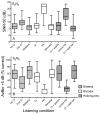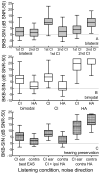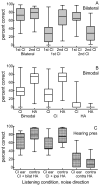Availability of binaural cues for bilateral implant recipients and bimodal listeners with and without preserved hearing in the implanted ear
- PMID: 24356514
- PMCID: PMC3932362
- DOI: 10.1159/000355700
Availability of binaural cues for bilateral implant recipients and bimodal listeners with and without preserved hearing in the implanted ear
Abstract
The purpose of this study was to examine the availability of binaural cues for adult, bilateral cochlear implant (CI) patients, bimodal patients and hearing preservation patients using a multiple-baseline, observational study design. Speech recognition was assessed using the Bamford-Kowal-Bench Speech-in-Noise (BKB-SIN) test as well as the AzBio sentences [Spahr AJ, et al: Ear Hear 2012;33:112-117] presented in a multi-talker babble at a +5 dB signal-to-noise ratio (SNR). Test conditions included speech at 0° with noise presented at 0° (S0N0), 90° (S0N90) and 270° (S0N270). Estimates of summation, head shadow (HS), squelch and spatial release from masking (SRM) were calculated. Though nonwwe of the subject groups consistently showed access to binaural cues, the hearing preservation patients exhibited a significant correlation between summation and squelch whereas the bilateral and bimodal participants did not. That is to say, the two effects associated with binaural hearing - summation and squelch - were positively correlated only for the listeners with bilateral acoustic hearing. This finding provides evidence for the supposition that implant recipients with bilateral acoustic hearing have access to binaural cues, which should, in theory, provide greater benefit in noisy listening environments. It is likely, however, that the chosen test environment negatively affected the outcomes. Specifically, the spatially separated noise conditions directed noise toward the microphone (mic) port of the behind-the-ear (BTE) hearing aid and implant processor. Thus, it is possible that in more realistic listening environments for which the diffuse noise is not directed toward the processor/hearing aid mic, hearing preservation patients have binaural cues for improved speech understanding.
Figures









Similar articles
-
Availability of binaural cues for pediatric bilateral cochlear implant recipients.J Am Acad Audiol. 2015 Mar;26(3):289-98. doi: 10.3766/jaaa.26.3.8. J Am Acad Audiol. 2015. PMID: 25751696 Free PMC article.
-
Benefits of bilateral electrical stimulation with the nucleus cochlear implant in adults: 6-month postoperative results.Otol Neurotol. 2004 Nov;25(6):958-68. doi: 10.1097/00129492-200411000-00016. Otol Neurotol. 2004. PMID: 15547426 Clinical Trial.
-
Pre- and Postoperative Binaural Unmasking for Bimodal Cochlear Implant Listeners.Ear Hear. 2017 Sep/Oct;38(5):554-567. doi: 10.1097/AUD.0000000000000420. Ear Hear. 2017. PMID: 28301390
-
Bilateral cochlear implants in children: Effects of auditory experience and deprivation on auditory perception.Hear Res. 2016 Aug;338:76-87. doi: 10.1016/j.heares.2016.01.003. Epub 2016 Jan 30. Hear Res. 2016. PMID: 26828740 Free PMC article. Review.
-
The benefit of bilateral versus unilateral cochlear implantation to speech intelligibility in noise.Ear Hear. 2012 Nov-Dec;33(6):673-82. doi: 10.1097/AUD.0b013e3182587356. Ear Hear. 2012. PMID: 22717687 Review.
Cited by
-
Impact of Reverberation on Speech Perception in Noise in Bimodal/Bilateral Cochlear Implant Users with and without Residual Hearing.J Clin Med. 2024 Sep 5;13(17):5269. doi: 10.3390/jcm13175269. J Clin Med. 2024. PMID: 39274482 Free PMC article.
-
The Temporal Fine Structure of Background Noise Determines the Benefit of Bimodal Hearing for Recognizing Speech.J Assoc Res Otolaryngol. 2020 Dec;21(6):527-544. doi: 10.1007/s10162-020-00772-1. Epub 2020 Oct 26. J Assoc Res Otolaryngol. 2020. PMID: 33104927 Free PMC article.
-
Combined Electric and Acoustic Stimulation With Hearing Preservation: Effect of Cochlear Implant Low-Frequency Cutoff on Speech Understanding and Perceived Listening Difficulty.Ear Hear. 2017 Sep/Oct;38(5):539-553. doi: 10.1097/AUD.0000000000000418. Ear Hear. 2017. PMID: 28301392 Free PMC article.
-
Unilateral Versus Bilateral Cochlear Implants in Adults: A Cross-Sectional Questionnaire Study Across Multiple Hearing Domains.Audiol Res. 2025 Jan 20;15(1):6. doi: 10.3390/audiolres15010006. Audiol Res. 2025. PMID: 39846559 Free PMC article.
-
Frequency-to-Place Mismatch: Characterizing Variability and the Influence on Speech Perception Outcomes in Cochlear Implant Recipients.Ear Hear. 2020 Sep/Oct;41(5):1349-1361. doi: 10.1097/AUD.0000000000000864. Ear Hear. 2020. PMID: 32205726 Free PMC article.
References
-
- Buss E, Pillsbury HC, Buchman CA, Pillsbury CH, Clark MS, Haynes DS, Labadie RF, Amberg S, Roland PS, Kruger P, Novak MA, Wirth JA, Black JM, Peters R, Lake J, Wackym PA, Firszt JB, Wilson BS, Lawson DT, Schatzer R, SDHP, Barco AL, Multicenter uS. Bilateral med-el cochlear implantation study: Speech perception over the first year of use. Ear Hear. 2008;29:20–32. - PubMed
-
- Dawson PW, Decker JA, Psarros CE. Optimizing dynamic range in children using the nucleus cochlear implant. Ear Hear. 2004;25:230–241. - PubMed
-
- Dillon H, Byrne D, Brewer S, Katsch R, Ching TY, Keidser G. Nal nonlinear version 1.01 user manual. National Acoustics Laboratories; 1998.
Publication types
MeSH terms
Grants and funding
LinkOut - more resources
Full Text Sources
Other Literature Sources
Medical
Miscellaneous

